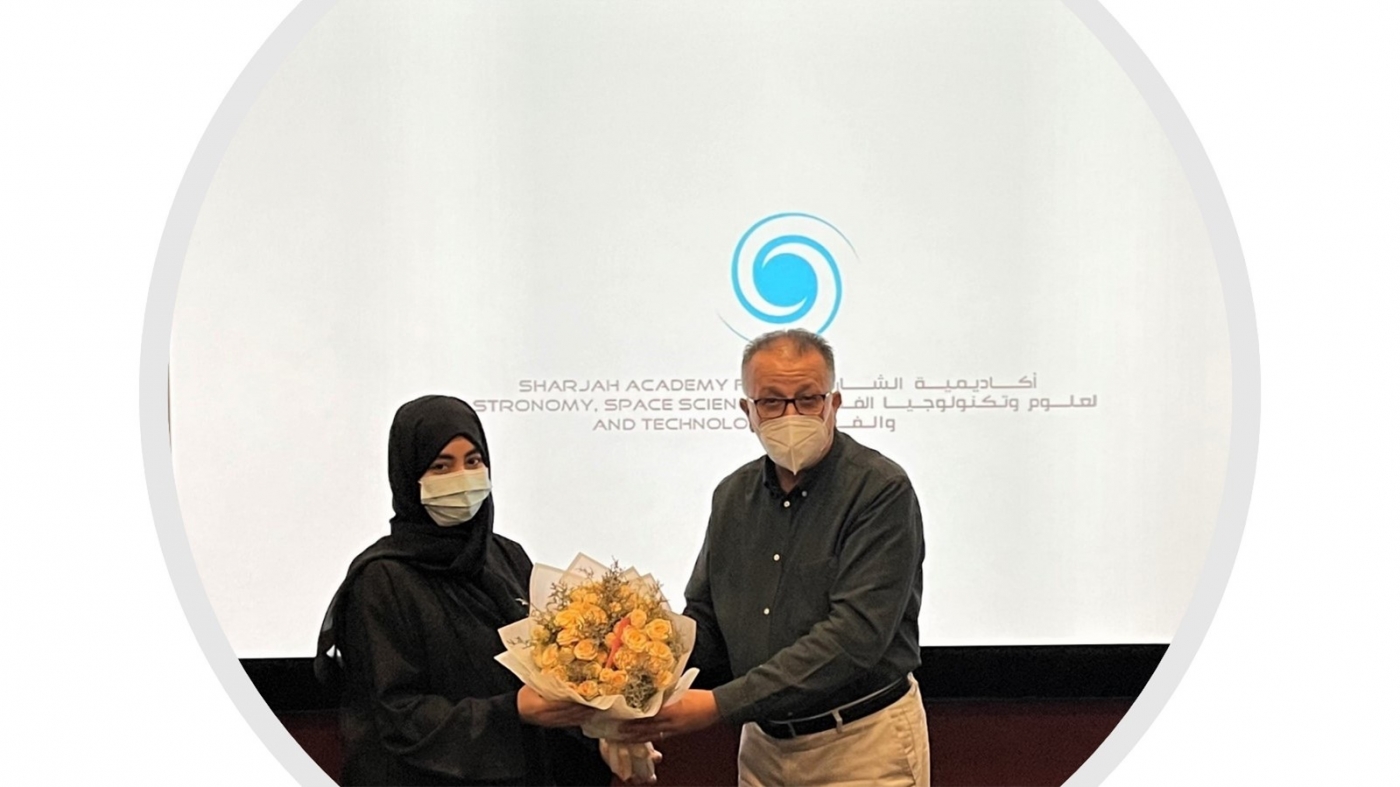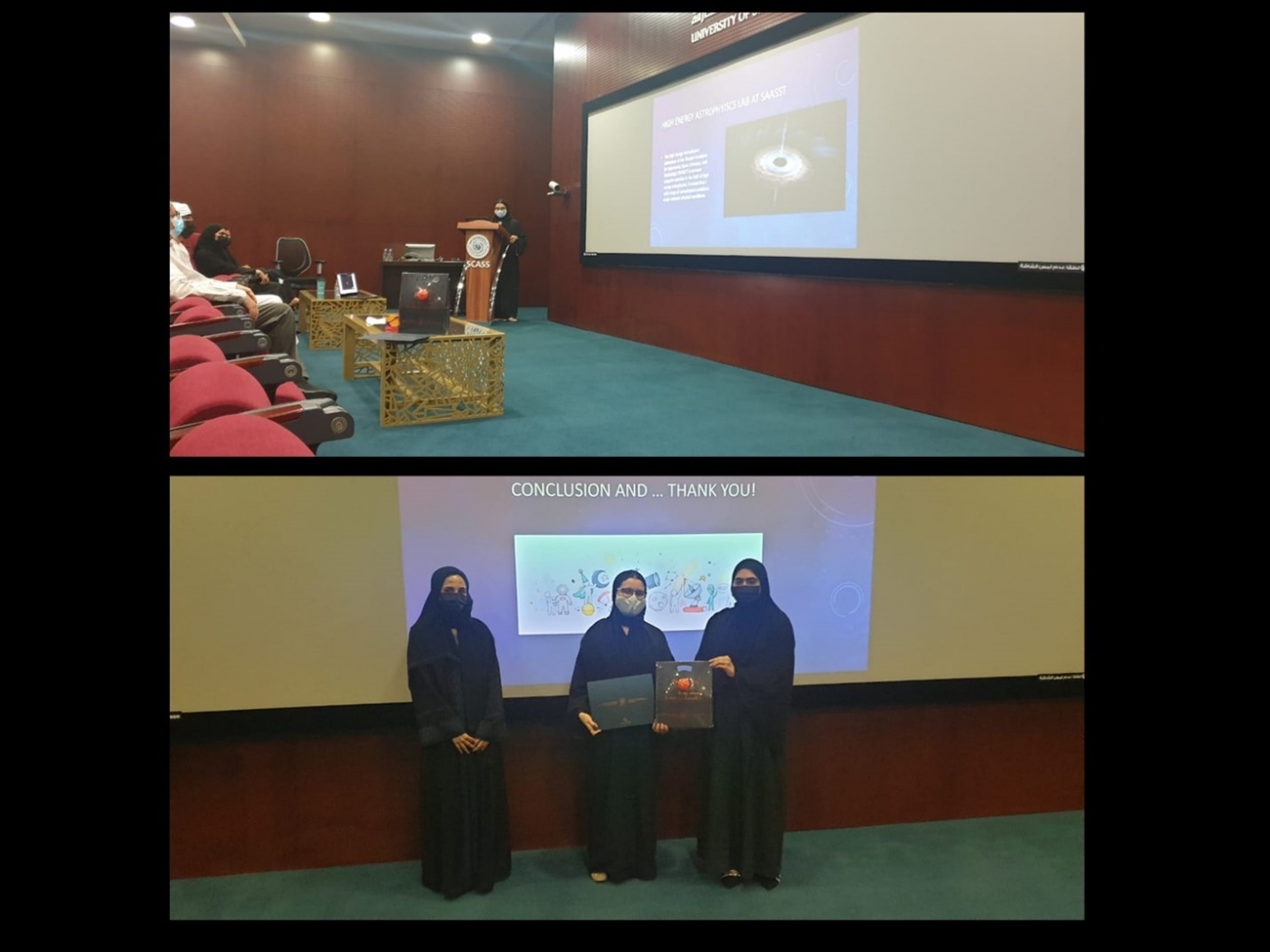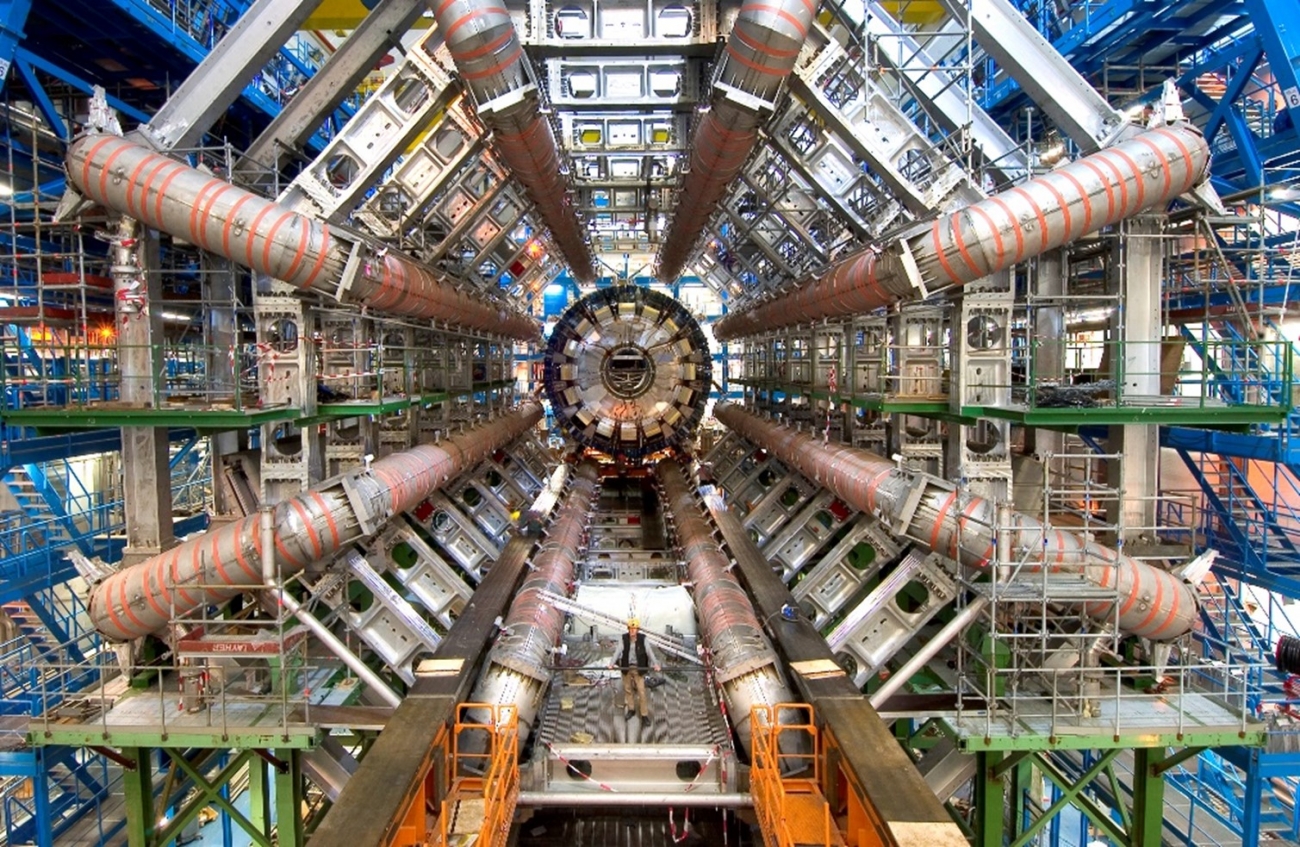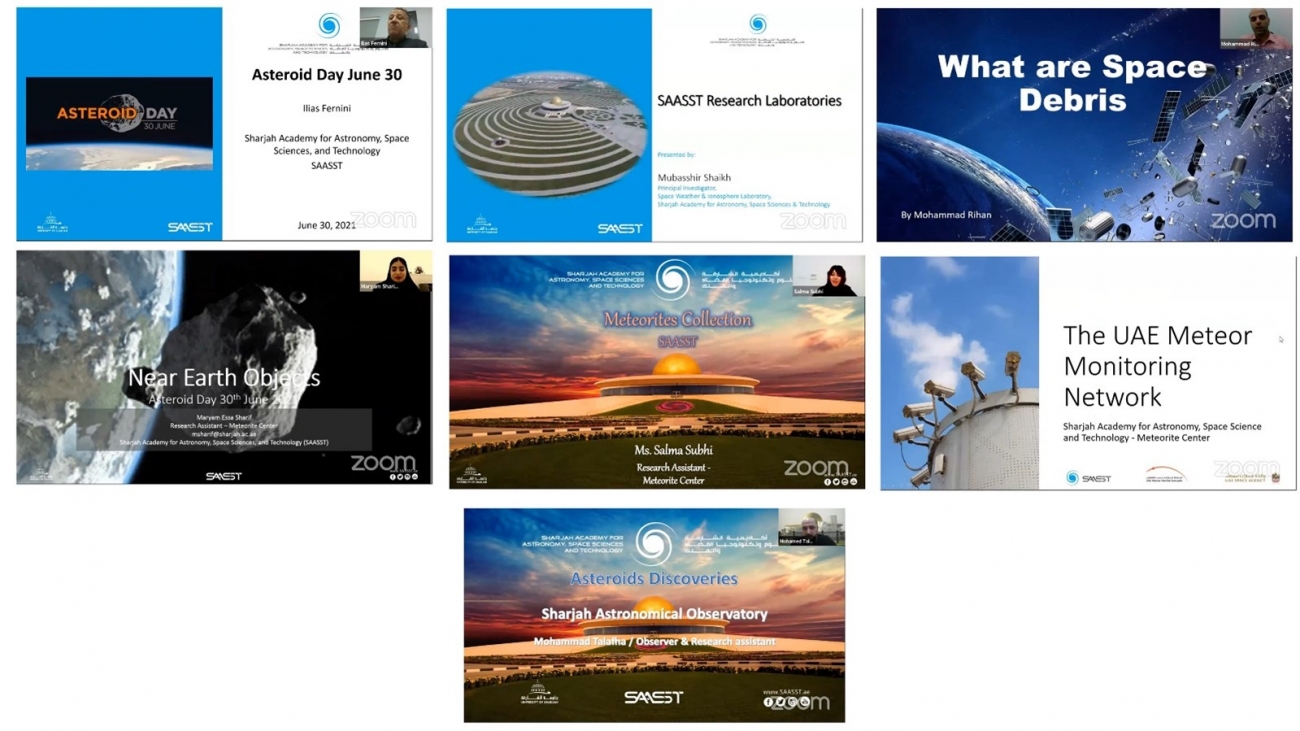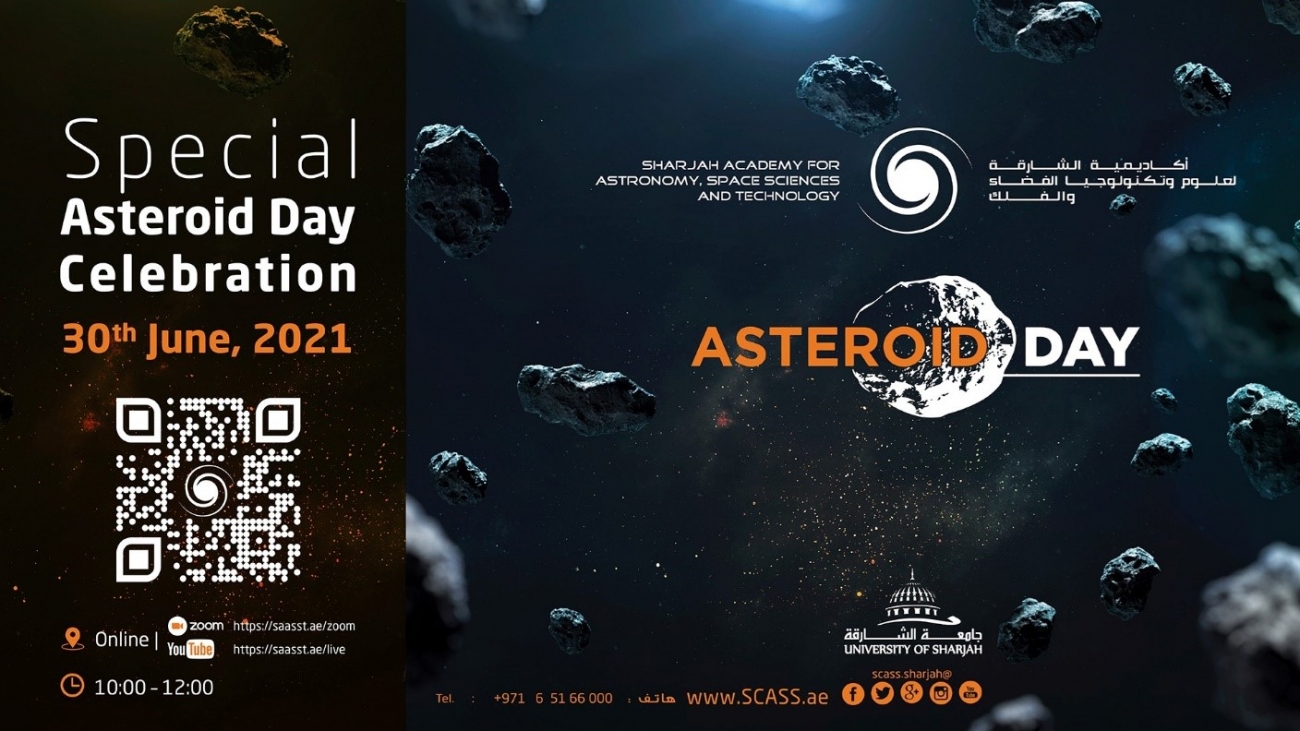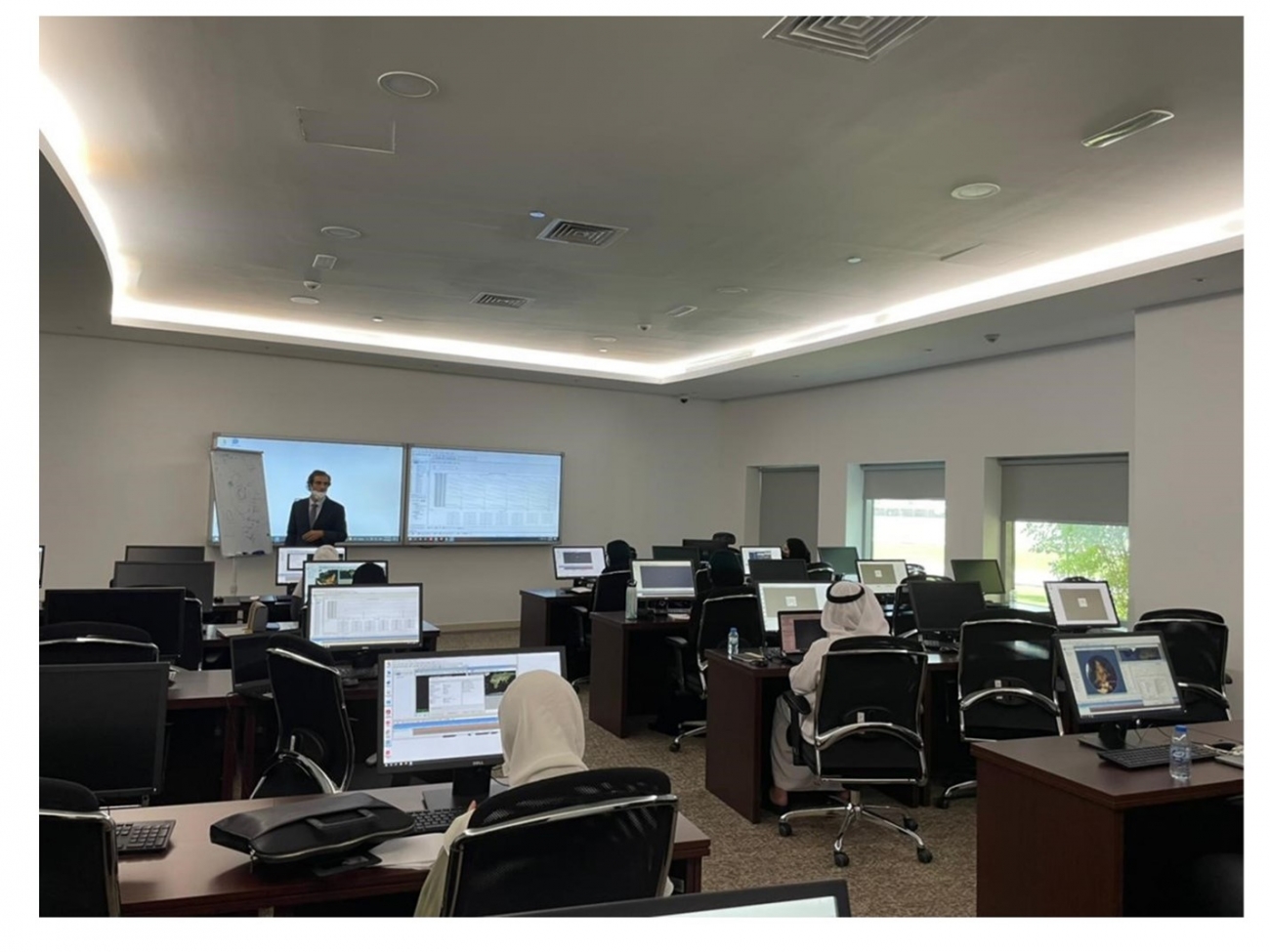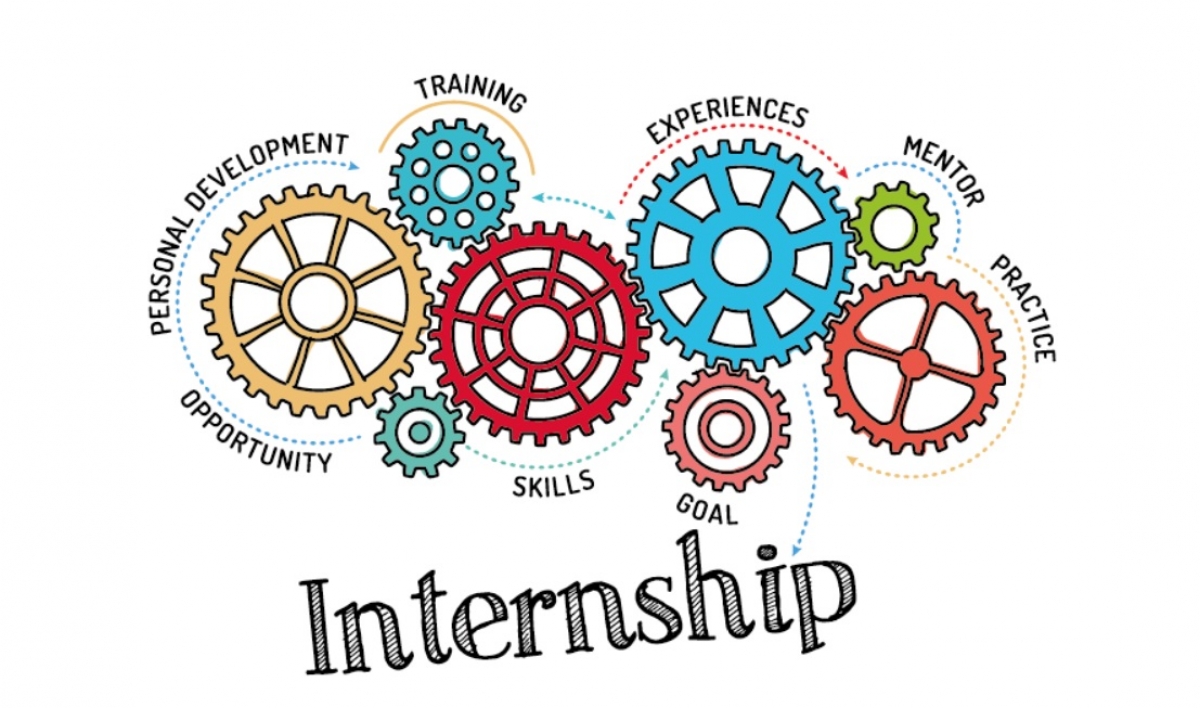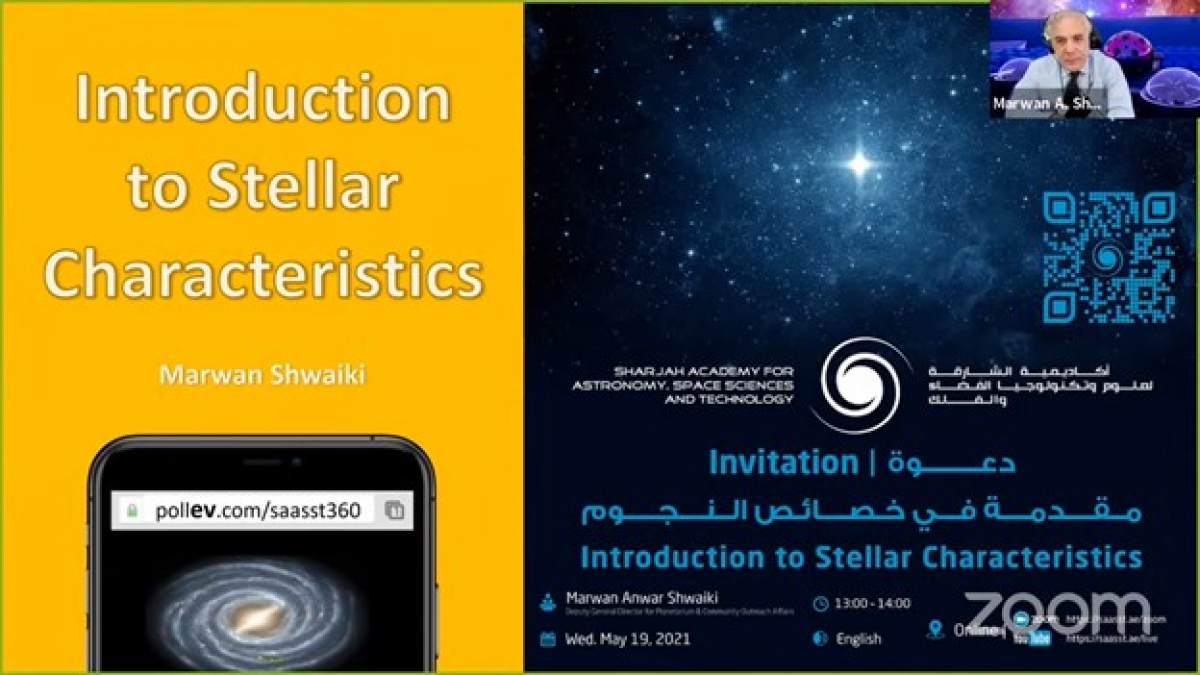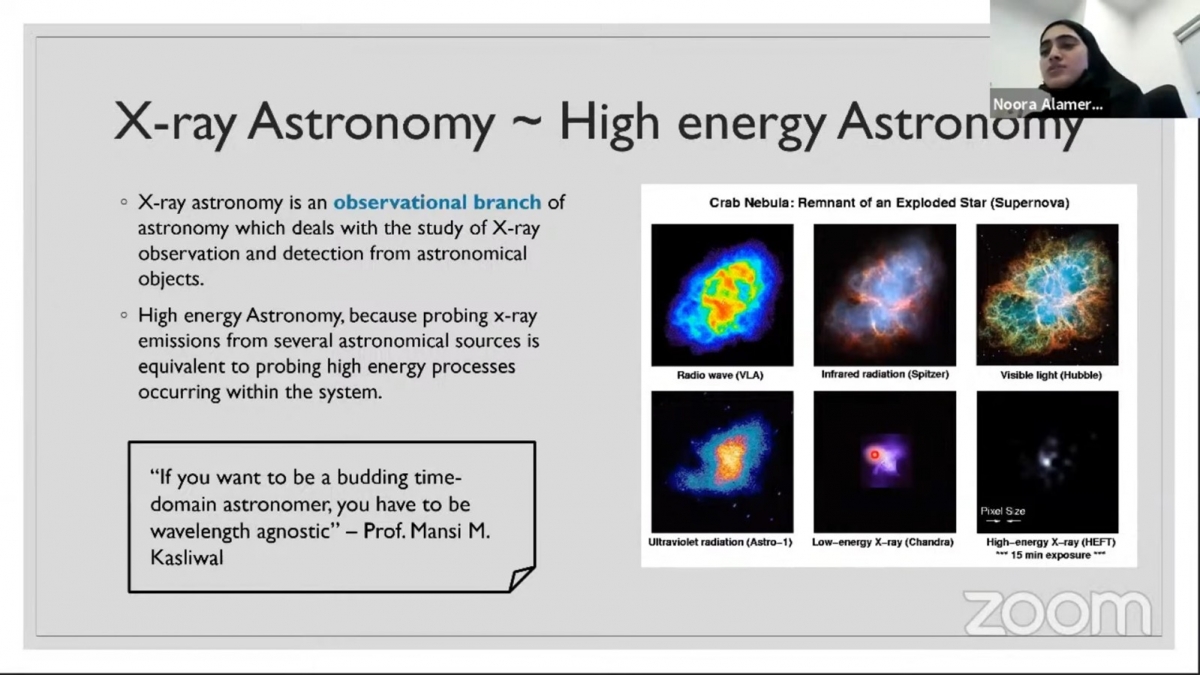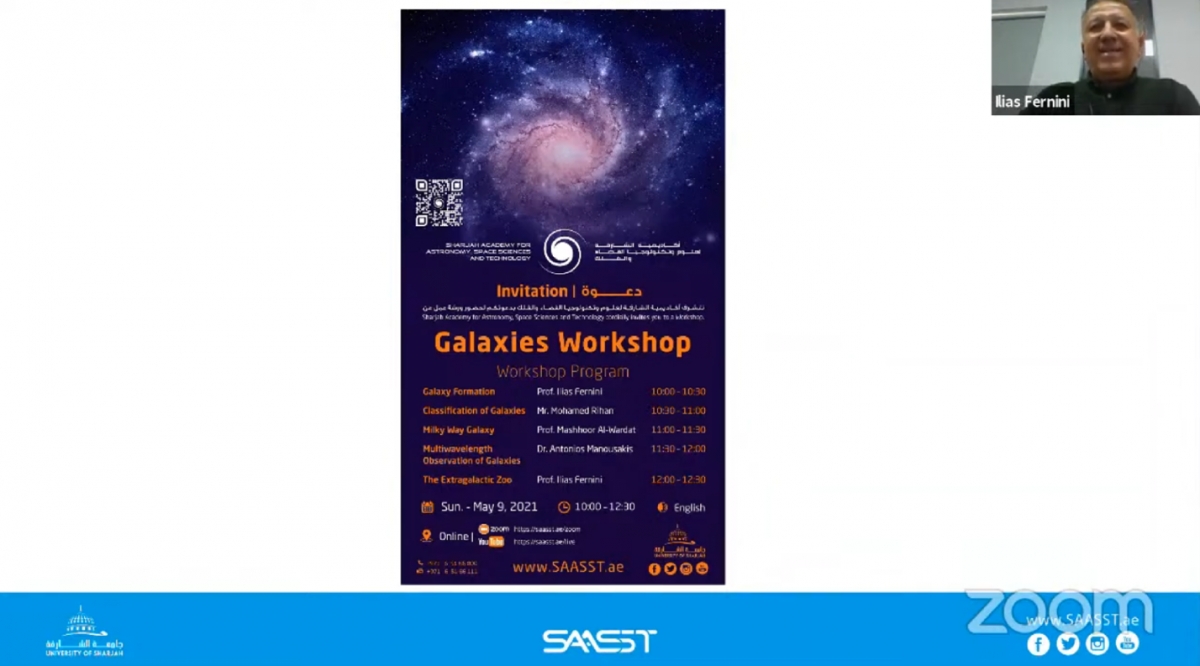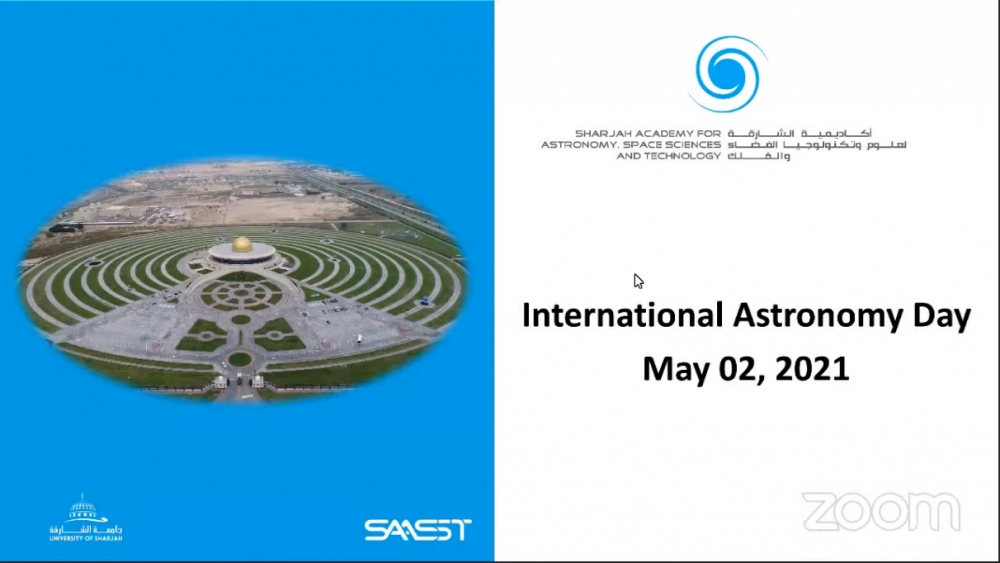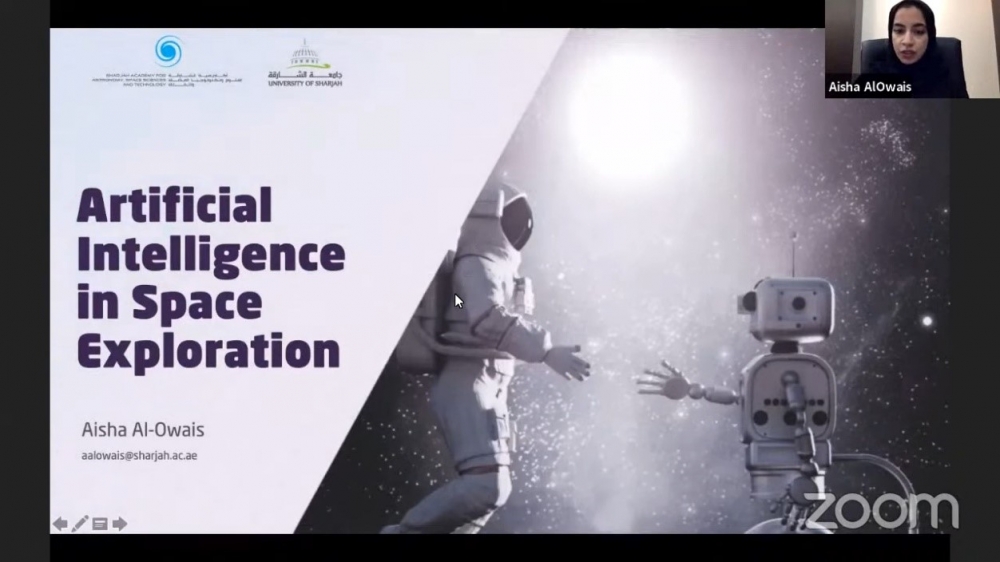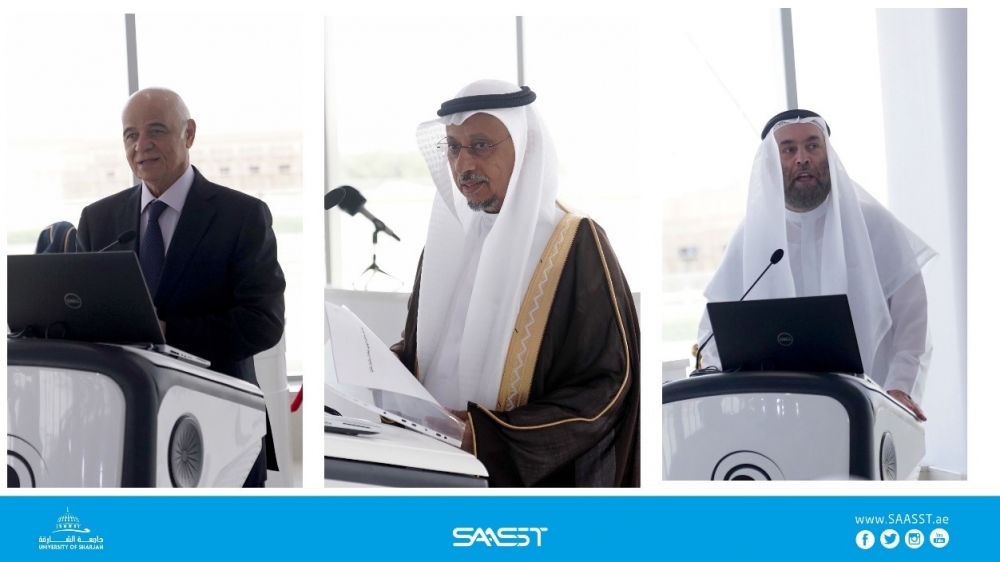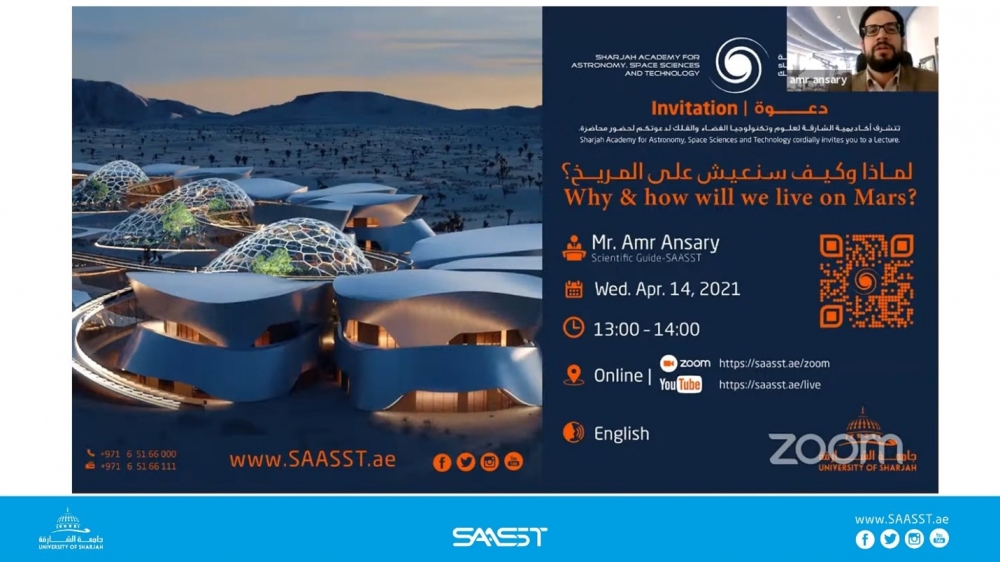Farewell Ceremony to Ms. Asmaa Abdulsalam Alhameed SAASST Research Assistant
The Sharjah Academy for Astronomy, Space Sciences, and Technology has organized an informal farewell ceremony on Jul. 29, 2021, to Ms. Asmaa Abdulsalam Alhameed, a SAASST research assistant at the Radio Astronomy Laboratory. Ms. Asmaa is leaving us for a teaching position in one of the UAE schools. She joined SAASST in 2017.
Ms. Raiyah Al-Serkal from AUS, First Student to Finish Her Summer Internship 2021 at SAASST
Ms. Raiyah Al-Serkal, a physics student from the American University of Sharjah, just finished her 2021 summer internship at the Sharjah Academy for Astronomy, Space Sciences, and Technology (SAASST). Ms. Raiyah started her internship on June 06 and gave her final presentation about her work on July 11. She worked at the High Energy Astrophysics Laboratory and was under the supervision of Dr. Antonios Manousakis, Ms. Noora Al-Ameri, and Ms. Maryam Al-Qasemi. Her main work was to do some computational and data analysis on X-ray binaries. Ms. Raiyah said she got tremendous experience working with real astronomical data obtained from the XMM X-ray space telescope.
The UAE Joins the ATLAS Collaboration at CERN in Switzerland
The United Arab Emirates has joined the European Organization for Nuclear and Particle Physics Research (CERN) in Geneva (Switzerland) as a Cluster Institution (University of Sharjah, New York University Abu Dhabi, and the United Arab Emirates University). A Memorandum of Understanding (MoU) on the cooperation among the three universities has been signed with CERN.
Great Online Attendance for the Asteroid Day Celebration
The Sharjah Academy for Astronomy, Space Sciences, and Technology (SAASST) celebrated on Wednesday, June 30, 2021, the International Asteroid Day. The main objectives of the asteroid day are to raise public awareness about the asteroid impact hazard, save the Earth from asteroids, and increase the asteroid discovery rate to 100,000 per year compared to a couple of hundreds per year. These goals can be achieved by using new technologies to detect and track Near-Earth-Asteroids (NEA) that threaten human populations. SAASST is within these objectives with its “Meteorite Center” and its different units, i.e., the “Analysis Unit,” “Machine Learning,” “Drone Unit,” and the “UAEMMN Unit.” In addition, seven various lectures on different topics related to asteroids were given by SAASST staff.
Asteroid Day June 30, 2021 Celebration
The Sharjah Academy for Astronomy, Space Sciences, and Technology (SAASST) will celebrate the International Asteroid Day on June 30, 2021. The main objectives of the asteroid day are to raise public awareness about the asteroid impact hazard, save the Earth from asteroids, and increase the asteroid discovery rate to 100,000 per year compared to a couple of hundreds per year. These goals can be achieved by using new technologies to detect and track
A Special STK Workshop for SAASST Summer Internship Students
The Sharjah Academy for Astronomy, Space Sciences, and Technology (SAASST) has organized a special STK workshop for the summer internship students on Jun. 14, 2021. Mrs. Tarifa Al-Kaabi, our research assistant at the CubeSat Laboratory, organized the workshop. Mr. Diogo Rodriguez, the AGI MENA Director, gave the workshop onsite. Due to the pandemic situation, some students participated online. Systems Tool Kit, often referred to by its initials STK, is a multi-physics software application from Analytical Graphics, Inc. that enables engineers and scientists to perform complex
SAASST Approves 21 Students for their Summer Internship - Training Program for 2021
As part of its program to educate university students and introduce them to space sciences research, the Sharjah Academy for Astronomy, Space Sciences, and Technology (SAASST) has approved the application of 21 students to take part in the different SAASST research laboratories. These students will have the chance to have their summer internship program at SAASST starting from June 06, 2021. The period may go up to 8 weeks ending in July 2021. Students come from the University of Sharjah, Khalifa University, the American University of Sharjah, and the Higher College of technology.
SAASST Bi-Weekly Lecture: Lecture on “Stellar Characteristics” by Mr. Marwan Shwaiki
As part of its program to enhance astronomy education, the Sharjah Academy for Astronomy, Space Sciences, and Technology (SAASST) organized a lecture on “Introduction to Stellar Characteristics” on May 19, 2021. The lecture was given by Mr. Marwan Shwaiki, the Deputy General Director for Plantarium and Outreach Program at SAASST. Mr. Marwan presented the properties of the different stars: brightness, color, surface temperature, size, and mass. The H-R diagram was introduced to explain stellar evolution that depends on one physical property of a star: its mass. A star can live billions or maybe trillions of years if its mass is low (less than 8 solar mass), or just a couple of millions of years if its mass is large (more than 8 solar mass).
Lecture on “X-ray Astronomy” by Ms. Noora Al-Ameri
As part of its program to enhance astronomy education, the Sharjah Academy for Astronomy, Space Sciences, and Technology (SAASST) organized a lecture on “X-ray Astronomy” on May 26, 2021. The lecture was given by Ms. Noora AL-Ameri, a research assistant at the SAASST High Energy Astrophysics Laboratory. Ms. Noora talked about the different types of objects that emit this X-ray radiation and the different physical processes responsible for this radiation. To observe X-ray radiation, space telescopes are used since X-ray radiation is absorbed by the Earth’s atmosphere, so instruments to detect X-rays must be taken to high altitude by balloons, sounding rockets, and satellites.
Workshop on Galaxies
As part of its program to enhance astronomy education, the Sharjah Academy for Astronomy, Space Sciences, and Technology (SAASST) has organized a special workshop dedicated to galaxies on May 09, 2021. The program of the online workshop was as follows:
More...
International Astronomy Day
As part of its program to enhance astronomy education, the Sharjah Academy for Astronomy, Space Sciences, and Technology (SAASST) celebrated the “International Astronomy Day” on May 02, 2021. The event was online due to current pandemic situation. All three units of SAASST participated in this celebration. More than 120 students followed the program online. The program was as follows:
Artificial Intelligence in Space Exploration
As part of its program to enhance astronomy education, the Sharjah Academy for Astronomy, Space Sciences, and Technology (SAASST) organized a lecture on “Artificial Intelligence in Space Exploration” on Apr. 28, 2021. The lecture was given by Ms. Aisha Al-Owais, a research assistant at the “Meteorite Center” and “Space Artificial Intelligence” at SAASST. Ms. Aisha presented a thorough presentation on the application of AI in space systems from spacecrafts to the study of the universe as a whole. Advances in AI have allowed us to make progress in all kinds of disciplines – and these are
Lunar Crescent Visibility Workshop
On Apr. 11, 2021, HE Prof. Hamid Al-Naimiy, the Chancellor of the University of Sharjah, opened the first lunar crescent visibility workshop under the title “Determination of Ramadhan and Shawwal 1442 AH Using Astronomical Calculations.” Prof. Hamid emphasized using precise astronomical knowledge to help determine the start of the Islamic months. At a time where technology is used everywhere, it is time for the Muslims to apply the latest technological astronomical tools to help set the Islamic calendar. The workshop was attended by several religious figures, i.e., HE Dr. Omar Habtoor Al-Darei, the Executive Director for Islamic Affairs at the General Authority of Islamic Affairs and Endowments, HE Dr. Hamad Al-Sheikh Ahmad Al-Shaibani, General Director of Islamic Affairs in Dubai, Prof. Awad Al-Khalaf, Acting Director of Qasimia University, and other religious authorities from Sharjah and Dubai. Prof. Mashhoor Al-Wardat, Prof. Ilias Fernini, and Mr. Mohamed Talafha gave different presentations that emphasized the different astronomical criteria used to set the conditions for the crescent visibility. The astronomers stressed the weather effects in making the observation of the crescent extremely challenging.
Why and how will we live on Mars?
As part of its program to enhance astronomy education, the Sharjah Academy for Astronomy, Space Sciences, and Technology organized a lecture on “Why and how will we live on Mars?” on Apr. 14, 2021. The lecture was given by Mr. Amr Ansary, a scientific guide at the SAASST Planetarium. Mr. Amr presented the pros and cons of going to Mars and settle there. Mars was believed to be a live planet 3.5 billion years ago. Its present-day dead environment is the subject of intense research to answer the following question: what happened to it? Its thin atmosphere is 96% of carbon dioxide. Its magnetic field is very localized, unlike Earth’s magnetosphere. Despite these striking differences with Earth, the Martian surface looks like any region here on Earth: plains, valleys, mountains, and deserts.



